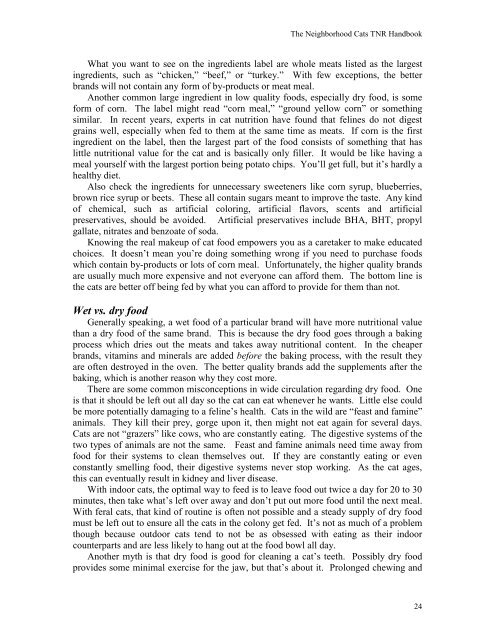Create successful ePaper yourself
Turn your PDF publications into a flip-book with our unique Google optimized e-Paper software.
The <strong>Neighborhood</strong> <strong>Cats</strong> <strong>TNR</strong> <strong>Handbook</strong><br />
What you want to see on the ingredients label are whole meats listed as the largest<br />
ingredients, such as “chicken,” “beef,” or “turkey.” With few exceptions, the better<br />
brands will not contain any form of by-products or meat meal.<br />
Another common large ingredient in low quality foods, especially dry food, is some<br />
form of corn. The label might read “corn meal,” “ground yellow corn” or something<br />
similar. In recent years, experts in cat nutrition have found that felines do not digest<br />
grains well, especially when fed to them at the same time as meats. If corn is the first<br />
ingredient on the label, then the largest part of the food consists of something that has<br />
little nutritional value for the cat and is basically only filler. It would be like having a<br />
meal yourself with the largest portion being potato chips. You’ll get full, but it’s hardly a<br />
healthy diet.<br />
Also check the ingredients for unnecessary sweeteners like corn syrup, blueberries,<br />
brown rice syrup or beets. These all contain sugars meant to improve the taste. Any kind<br />
of chemical, such as artificial coloring, artificial flavors, scents and artificial<br />
preservatives, should be avoided. Artificial preservatives include BHA, BHT, propyl<br />
gallate, nitrates and benzoate of soda.<br />
Knowing the real makeup of cat food empowers you as a caretaker to make educated<br />
choices. It doesn’t mean you’re doing something wrong if you need to purchase foods<br />
which contain by-products or lots of corn meal. Unfortunately, the higher quality brands<br />
are usually much more expensive and not everyone can afford them. The bottom line is<br />
the cats are better off being fed by what you can afford to provide for them than not.<br />
Wet vs. dry food<br />
Generally speaking, a wet food of a particular brand will have more nutritional value<br />
than a dry food of the same brand. This is because the dry food goes through a baking<br />
process which dries out the meats and takes away nutritional content. In the cheaper<br />
brands, vitamins and minerals are added before the baking process, with the result they<br />
are often destroyed in the oven. The better quality brands add the supplements after the<br />
baking, which is another reason why they cost more.<br />
There are some common misconceptions in wide circulation regarding dry food. One<br />
is that it should be left out all day so the cat can eat whenever he wants. Little else could<br />
be more potentially damaging to a feline’s health. <strong>Cats</strong> in the wild are “feast and famine”<br />
animals. They kill their prey, gorge upon it, then might not eat again for several days.<br />
<strong>Cats</strong> are not “grazers” like cows, who are constantly eating. The digestive systems of the<br />
two types of animals are not the same. Feast and famine animals need time away from<br />
food for their systems to clean themselves out. If they are constantly eating or even<br />
constantly smelling food, their digestive systems never stop working. As the cat ages,<br />
this can eventually result in kidney and liver disease.<br />
With indoor cats, the optimal way to feed is to leave food out twice a day for 20 to 30<br />
minutes, then take what’s left over away and don’t put out more food until the next meal.<br />
With feral cats, that kind of routine is often not possible and a steady supply of dry food<br />
must be left out to ensure all the cats in the colony get fed. It’s not as much of a problem<br />
though because outdoor cats tend to not be as obsessed with eating as their indoor<br />
counterparts and are less likely to hang out at the food bowl all day.<br />
Another myth is that dry food is good for cleaning a cat’s teeth. Possibly dry food<br />
provides some minimal exercise for the jaw, but that’s about it. Prolonged chewing and<br />
24


